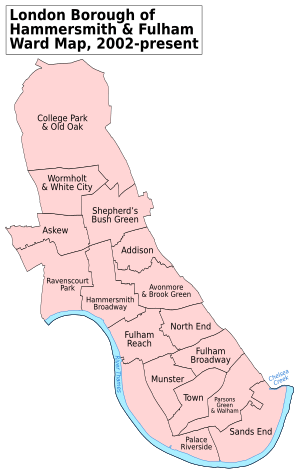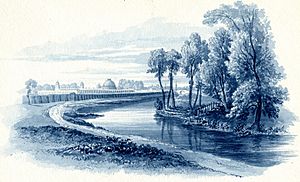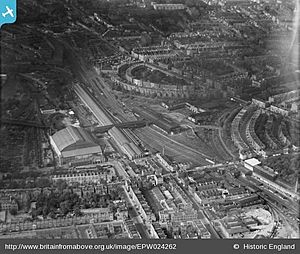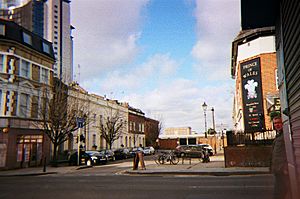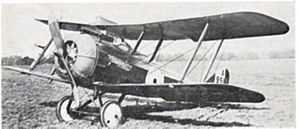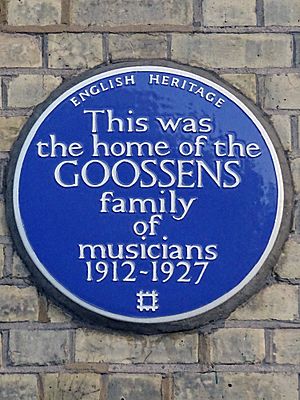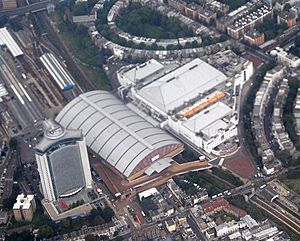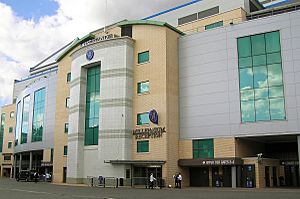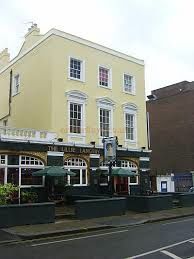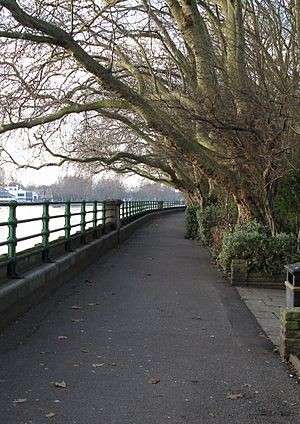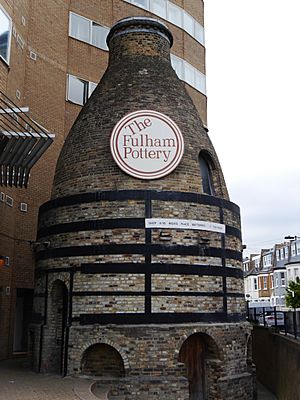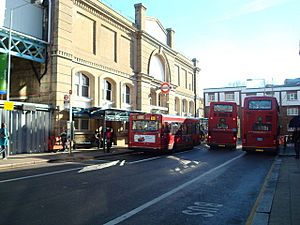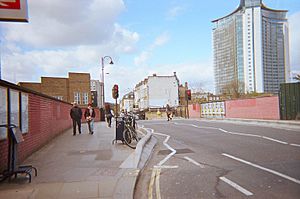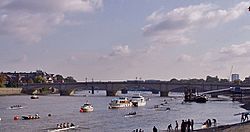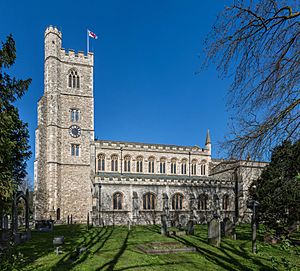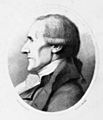Fulham facts for kids
Quick facts for kids Fulham |
|
|---|---|
 Fulham Palace, the former residence of the Bishop of London |
|
| Population | 87,161 (2011) |
| OS grid reference | TQ245765 |
| • Charing Cross | 3.6 mi (5.8 km) NE |
| Ceremonial county | Greater London |
| Region | |
| Country | England |
| Sovereign state | United Kingdom |
| Post town | LONDON |
| Postcode district | SW6, W14, W6 |
| Dialling code | 020 |
| Police | Metropolitan |
| Fire | London |
| Ambulance | London |
| EU Parliament | London |
| UK Parliament |
|
Fulham is a lively area in West London, England. It's about 6 kilometers (3.6 miles) southwest of central London. Fulham sits on the north side of the River Thames, with Hammersmith, Kensington, and Chelsea nearby. Across the river, you can see places like Wandsworth and the London Wetland Centre.
Fulham has a long history, first mentioned way back in 691. It used to be a large area that included Hammersmith. From 1900 to 1965, Fulham was its own borough. Then, it joined with Hammersmith to form the London Borough of Hammersmith and Fulham.
For centuries, Fulham has been a place of industry and business. In the 17th and 18th centuries, people made pottery, tapestries, paper, and brewed beer here. Later, it became known for cars, early airplanes, food production, and laundries. In the 19th century, glass blowing was popular, and it has even made a comeback recently.
Fulham is also famous for its sports. Two big football clubs, Fulham and Chelsea, have their stadiums here. Other well-known sports clubs include the Hurlingham Club, famous for polo, and the Queen's tennis club, which hosts a big tennis tournament before Wimbledon every year.
Contents
History of Fulham
Early Days & Fulham Palace
The name "Fulham" might mean "place of fowls" or "muddy place," possibly because the River Thames used to flood it. Another idea is that it means "land in a river bend belonging to a chief named Fulla."
Around the year 691, the area of Fulham was given to Bishop Erkenwald. For 900 years, Fulham Palace was the summer home for the Bishops of London. In 879, Danish invaders even spent the winter in Fulham and Hammersmith.
Recently, people have become very interested in Fulham's ancient past. The Fulham Archaeological Rescue Group has done digs, finding evidence that Neolithic people lived by the river about 5,000 years ago. They also found signs of Roman settlements from the 3rd and 4th centuries AD.
Fulham Parish & Old Buildings
We don't know exactly when the first church was built in Fulham, but records show a church existed in 1154. The first known priest for All Saints Church, Fulham was appointed in 1242. The old part of All Saints Church was taken down in 1881 to make it bigger, but it was already from the 15th century. There's a similar old church, St Mary's Church, Putney, just across the River Thames.
In 1642, the Earl of Essex built a bridge of boats across the river. This allowed his army to chase King Charles I. This bridge was likely near where the old wooden Fulham Bridge was built in 1729. That bridge was later replaced by Putney Bridge in 1886.
Margravine Road is named after Brandenburg House, a large house by the river. It was built by Sir Nicholas Crispe in the time of King Charles I. Later, in 1792, it was home to Charles Alexander, Margrave of Brandenburg-Ansbach and his wife. In 1820, Caroline, the wife of King George IV, lived there.
Until 1834, the nearby village of Hammersmith was part of Fulham. But as the population grew, they decided to create separate areas for easier management. They didn't join up again until 1965.
19th Century: Transport & Power
The 19th century brought big changes to Fulham. The quiet villages and market gardens started to grow with new power sources and transport. This led to more people moving in and learning new skills.
In 1824, the Imperial Gas Light and Coke Company, the world's first public utility company, bought land in Sands End. They made gas for lighting. Their old gas holder, built in 1830, is thought to be the oldest in the world!
Another idea was to turn a water channel into a canal. This Kensington Canal was meant to link the Grand Union Canal with the Thames. It opened in 1828, but by then, railways were becoming more popular. However, the canal project led to new developments like houses and roads, including Lillie Road. It also helped create two railway lines: the West London line and the District line. These lines connected South London with the rest of the city. Important engineers like Robert Stephenson and Sir John Fowler helped with these projects.
The area around Lillie Bridge Depot became very important for London's public transport. It helped build and maintain the London Underground for over a century. The London Omnibus Co. in Seagrave Road helped change horse-drawn buses to motor buses. This brought many other car-related businesses to Fulham.
During the First World War, the Empress Hall was used to house Belgian refugees. In the 1880s, the old village of North End was greatly redeveloped. Many houses were built, and the area was renamed "West Kensington" to sound more appealing, like the richer area next door.
The last farm in Fulham, Crabtree Farm, closed in the early 1900s. A local historian, Charles James Féret, wrote a detailed history of Fulham in 1900, recording all these changes.
Art & Craft in Fulham
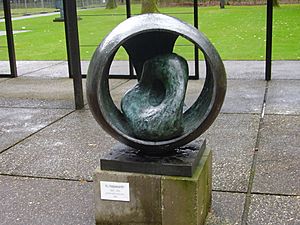
Fulham has a long history of making things, especially ceramics and woven goods, going back to the 17th century. The Fulham Pottery was very famous. Later, tapestry and carpet making started here.
Many artists have lived and worked in Fulham. William De Morgan, a potter and writer, lived in Sands End with his painter wife, Evelyn De Morgan. Another artist couple, Georgiana Burne-Jones and Edward Burne-Jones, lived at 'The Grange' in North End. Both couples were friends with William Morris.
Other artists included Francesco Bartolozzi, an Italian engraver, and Benjamin Rawlinson Faulkner, a portrait painter. Henri Gaudier-Brzeska, a French artist, lived in Walham Green until his early death in 1915.
Glass making was also important. The Glass House in Lettice Street was a special studio for Stained glass. The Art Bronze Foundry, started in 1922, still operates in Michael Road. It has made sculptures by famous artists like Henry Moore and Barbara Hepworth. You can see their work all over the world!
20th Century Changes

For the first half of the 20th century, Fulham was mainly a working-class area. People moved here from the countryside for jobs in factories and to serve the richer parts of London. There was some poverty, as noted by writers like Charles Dickens. Many charities, like the Peabody Trust, helped provide affordable housing.
A large hospital, 'The Western Hospital', was built in 1876 to treat fevers. It later became a top NHS center for treating polio until it closed in 1979.
Besides brewing, major industries included car and early airplane making (like Rolls Royce and Rover), rail engineering, and laundries. Later, there was gin distilling, food processing (like Telfer's Pies), and Kodak's photo processing.
North End Road became Fulham's main shopping street, with department stores and shops like Woolworth's and Marks & Spencer. The second ever Tesco shop opened here! The UK's oldest independent health food shop, opened in 1966, is still in the Fulham Road.
After World War II, many old buildings in Fulham were taken down. They were replaced by new buildings, including the Empress State Building and much-needed social housing.
Aviation History
Geoffrey de Havilland, a famous aviation pioneer, built his first airplane in his Fulham workshop in 1909. During World War I, a brewery site in Fulham was used to make aircraft. The Darracq Motor Engineering Company also made airplanes and parts for the Airco company during the war.
Musical Heritage
Many musicians have lived in Fulham. William Crathern, a composer, was an organist at St Mary's church. Edward Elgar, another famous composer, lived on Avonmore Road from 1890-1891.
The Goossens family, a famous musical family from Belgium, settled in Fulham. They included the conductor and composer Sir Eugene Aynsley Goossens, the oboist Léon Jean Goossens, and harpists Marie and Sidonie Goossens. They lived on Edith Road. The musician Elvis Costello also spent part of his youth in Fulham.
Modern Fulham: A Changing Area
In the 21st century, Fulham has become one of the most expensive areas in London. There are plans for big new developments, including tall luxury buildings. These plans have caused some debate, as they involve taking down older buildings and moving residents.
One large project involves the Earl's Court exhibition grounds. This project means taking down the exhibition centers and many homes and businesses. It also means closing the historic Lillie Bridge Depot, which opened in 1872.
What's in a Name?
The word "fulham" can also mean a special kind of dice! The Chambers Dictionary says a "fulham" is a 'die loaded at the corner to ensure that certain numbers are thrown'. The OED explains that a "high fulham" would make you roll a 4, 5, or 6, while a "low fulham" would make you roll a 1, 2, or 3. It's a fun fact about the name!
Sports, Fun & Lifestyle
Sports in Fulham
Fulham is a big sports hub! Before the Fulham FC stadium Craven Cottage and the Chelsea FC stadium Stamford Bridge were built, the Lillie Bridge Grounds was a key sports venue. It's where British amateur athletics began, and the first official Boxing matches under Marquess of Queensberry Rules took place there.
Fulham is home to two very exclusive sports clubs: the Queen's Club for tennis and the Hurlingham Club. The Hurlingham Club is known for polo, and its waiting list for membership can be over fifteen years long!
You can find public tennis courts at the entrance to Fulham Palace and on Eel Brook Common. Hurlingham Park also has tennis courts, which are sometimes used for netball. Hurlingham Park hosts the yearly Polo in the Park tournament, a popular event. The Hurlingham Club is the historic home of polo in the UK.
Rugby is played on Eel Brook Common and South Park. For swimming, there's Fulham Pools at Normand Park. Fulham also has connections to the old game of Real tennis. There are courts at the Queen's Club, and a famous designer of these courts, Joseph Bickley, lived in Lillie Road.
Fulham has five active Bowls clubs: The Bishops Park Bowls club, The Hurlingham Park Bowls Club, Normand Park Bowls Club, The Parson's Green Bowls club and The Winnington in Bishops Park.
Entertainment & Fun
After the Lillie Bridge Grounds closed in 1888, the biggest entertainment spots were the Empress Hall and Earl's Court II. The Empress Hall, built in 1894, hosted amazing shows and ice skating events. Earl's Court II, opened by Princess Diana, closed in 2014. These areas are now being redeveloped.
Fulham used to have two theaters, both opened in 1897. The 'Grand Theatre' was near Putney Bridge, and the 'Granville Theatre' was in Walham Green. Both have been replaced by office buildings.
Even though old venues are gone, the performing arts are still strong in Fulham. There's the Fulham Symphony Orchestra and the successful Fulham Opera. Many churches, like St John's Parish Church, host concerts.
You can catch a movie at the cinema complex in the Fulham Broadway Centre. Fulham Town Hall, built in 1888, is a popular place for concerts and dances. The heart of the old village of Walham Green has been made into a pedestrian area with cafes, bars, and a dance studio in the old Fulham Public Baths.
Gin, Breweries & Pubs
Fulham has a long history of brewing beer, going back to the 17th century with the Swan Brewery. Later, the North End Brewery and Cannons opened. In 1890, the alcohol-free Kops Brewery started, but it closed in 1917 and became a margarine factory.
Gin distilling also came to Fulham. Burnett's, makers of White Satin Gin, operated here for almost a century. None of the old breweries are left today.
Despite that, Fulham still has many pubs and gastropubs. The oldest pub is the Lillie Langtry on Lillie Road, built in 1835. It was originally called the Lillie Arms and served canal workers and later railway builders.
Some pubs are Grade II listed buildings, meaning they are historically important. These include the Duke on the Green and Aragon House (both facing Parsons Green), the Cock in North End Road, and the Temperance in Fulham High Street.
Green Spaces
Fulham has several lovely parks and open spaces. The biggest ones are Bishop's Park, Fulham Palace Gardens, Hurlingham Park, South Park, Eel Brook Common, and Parsons Green.
Other green spots include Normand Park and the Lillie Road Recreation Ground. The River Thames riverside walk in Bishop's Park is a great place to stroll and see the river and the countryside on the other side. It's part of the Thames Path.
Architectural Heritage
Many of Fulham's old grand houses and industrial buildings were lost to development or war. But the ancient Fulham Palace, the home of the Bishops of London, is still a treasure. It has medieval and Tudor parts, and its moat is the longest in England! Some parts of the palace are Grade I listed, meaning they are very important.
Other interesting buildings include the last remaining cone-shaped kiln of the Fulham Pottery. Broomhouse Lane has old cottages and the Gothic revival Castle Club. The Vineyard on Hurlingham Road dates back to the 17th century. The Hurlingham Club and its grounds are from the 18th century and are also listed.
North End Road has some notable buildings, like 'Crowthers' from 1712. Church Gate leads to All Saints Church, which has a 14th-15th century tower. The New King's Road has several beautiful 18th and early 19th-century homes, all Grade II listed.
Much of Fulham's architecture shows its busy 19th-century industrial growth. Many buildings are 'low-rise' and were built with local bricks. You can still see a small part of the old canal bridge from 1826 near West Brompton station.
Fulham in Pop Culture
Fulham is mentioned in many songs and has appeared in films!
- Willesden Green by The Kinks starts with: Well I tried to settle down Fulham Broadway.
- Jethro Tull's album Passion Play includes: There was a rush along the Fulham Road/There was a hush in the Passion Play.
- London's Brilliant Parade by Elvis Costello says: From the gates of St. Mary's/There were horses in Olympia/And a trolley bus in Fulham Broadway.
- What A Waste by Ian Dury and the Blockheads has the lines: I could be a writer with a growing reputation/I could be a ticket man at Fulham Broadway Station.
- Kiss Me Deadly by Generation X talks about Fulham in the 1970s: Having fun, in South West Six, and Hustling down the Fulham Road/Doing deals with Mr Cool.
- The punk band The Lurkers named their 1978 album Fulham Fallout.
- Maladjusted by Morrissey includes: As the Fulham Road lights/Stretch and invite into the night/From a Stevenage overspill/We'd kill to live around SW6.
- Ejector Seat Reservation by Swervedriver has the line: And just don't tell me the Fulham score.
- Take That sang: At Fulham Broadway Station, I see them every day in their song Pretty Things.
- Hip-hop artist Example released a comedy song, You Can't Rap, with the line: You can't rap, my friend/You're white and you're from Fulham.
Fulham has also been seen in films like The Omen and The L-Shaped Room. Fulham Broadway tube station was used in Sliding Doors.
Education in Fulham
Fulham has many schools, including private primary and preparatory schools. Some notable secondary schools are the Grade II listed Fulham Cross Girls School, The Oratory School, Lady Margaret School, and Henry Compton School. There's also a French primary school, 'Marie d'Orliac', for the large French-speaking community.
Interior Design
Fulham's artistic past continues with many specialist shops for interior design. You can find antique shops on Lillie Road and Munster Road. The New King's Road has many interior design shops and galleries, especially near Lots Road and Kings Road, Chelsea. Chelsea Harbour is also a popular spot for interior designers.
Transport Links
Fulham is located in a bend of the River Thames, across from Barnes and Putney. It has several District line tube stations: Putney Bridge, Parsons Green, Fulham Broadway, West Kensington, and Baron's Court.
The London Overground West London line stops at West Brompton and Imperial Wharf in Sands End. An old station, Chelsea and Fulham, used to be on this line but closed after World War II bomb damage.
Main Roads
Major roads crossing Fulham include:
- The Talgarth Road (A4)
- Fulham Palace Road (A218)
- Fulham Road (A219)
- The New King's Road (A308)
- Wandsworth Bridge Road (A217)
- Dawes Road (A3219)
- Lillie Road (A3218)
River Crossings
You can cross the river by road using:
- Wandsworth Bridge
- Putney Bridge
- Lillie Bridge (now over railway lines)
- Counter's Bridge at Olympia
By rail, you can cross using:
- Cremorne Bridge
- Fulham Railway Bridge
Places to Visit
- Fulham Palace
- Fulham Pottery
- Margravine Cemetery
- Bishops Park
- Chelsea Harbour
- Stamford Bridge (stadium) (Chelsea FC stadium)
- All Saints Church, Fulham
- Craven Cottage (Fulham FC stadium)
- New King's Road
- Riverside Studios (currently closed for updates)
- South Park
John Rocque's 1746 Map
This old map from 1746 by John Rocque shows Fulham in the loop of the River Thames. You can clearly see Counter's Creek on the left side.
| B | ||
|---|---|---|
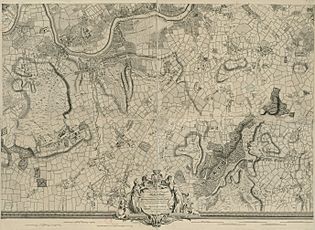 |
2 | |
| This sheet extract is a clickable image for enlargement | ||
Famous People from Fulham
Many interesting people have lived in Fulham throughout history:
- Sir William Butts (1486–1545), a doctor for King Henry VIII.
- Nell Gwyn (1650–1687), a companion to Charles II of England.
- Joseph Addison (1672–1719), a famous writer.
- Samuel Richardson (1689–1761), a well-known writer and printer.
- Maria Fitzherbert (1756–1837), who may have secretly married King George IV.
- Granville Sharp (1735–1813), who fought to end slavery.
- Edward Burne-Jones (1833–1898) and Georgiana Burne-Jones (1840–1920), both famous artists.
- William De Morgan (1832–1917) and Evelyn De Morgan (1855–1919), a husband and wife who were both artists and potters.
- Charles Rolls (1877–1910), who helped start Rolls Royce Limited and was an early airplane pilot.
- Henri Gaudier-Brzeska (1891–1915), a French sculptor and artist.
- Geoffrey de Havilland (1882–1965), a pioneer in aviation who built his first airplane in Fulham.
- The Goossens family, a talented musical family including conductor Sir Eugene Aynsley Goossens and oboist Léon Jean Goossens.
- Linford Christie (born 1960), an Olympic athlete.
- Daniel Radcliffe (born 1989), the actor famous for playing Harry Potter.
- Janet Street-Porter (born 1946), a well-known journalist.
- Elvis Costello, the musician, spent part of his youth here.
Images for kids
-
Portrait of William Butts, doctor to King Henry VIII. He came from Fulham.
-
Kneller's portrait of Joseph Addison of Sands End.
See also
 In Spanish: Fulham para niños
In Spanish: Fulham para niños



